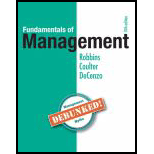
To Determine:
If the job of the leader to focus on the task and the people too simplistic.
Introduction:
Every leader has his/her own style of leading a team of people. We can broadly classify the leadership types as "Task-Oriented" and "Team-Oriented".
Answer to Problem 1TAI
Solution:
Understanding the focus of each type of leader and their priorities.
Explanation of Solution
A task oriented leader does the role of getting any specific job done. Such a leader has very clear information on finger-tips about how to proceed with a task and execute it. They often do not bother about consultation, advice, and ideas of employees. For them, the task becomes the first priority. While employees and their views are second. In task-oriented leadership, the main advantage is that the goals, procedures, and objectives are clear and co-relate with vision. Task-oriented leaders usually do not bother to involve fellow team members to make decisions. As an example, a task-oriented leader is least bothered about whether you complete your task in 2 hours or 10 hours, he is happy as long as the task is done and is good.
On the other hand, team-oriented leaders have their team members' inputs as their first priority. Such leaders emphasize building the team and keep strengthening the bond inside the team. They like to include their fellow members in the process of decision making, make more room for employees to come up and share their ideas, work on igniting creativity within a team. They focus on people who are simplistic and always keep working on ideas to bring their best performance. Such leaders have work-life balance as their area of interest.
For a management, it is of utmost importance to have a leader for their people. From a higher management perspective, organization goals are usually fulfilled and achieved by both kinds of leaders and results are identical in most cases.
Want to see more full solutions like this?
Chapter 12 Solutions
Fundamentals of Management (10th Edition)
- Dubai man-made island projects Should the risk events have been identified in the beginning by practicing sound quality control? Explain why or why not with details.arrow_forwardExplain why a Dubai man-made island project manager, or any stakeholder, should include uncertainty outcomes in their risk management practices.arrow_forwardDubai man-made islands What would be your quality assurance recommendations for such projects in the future based on the project in this case?arrow_forward
- What quality management components should be considered for a project such as the Dubai man-made islands? Explain your positionarrow_forwardWhat are your risk management, quality management, contingency planning, and uncertainty recommendations for any future Dubai man-made island projects?arrow_forwardWhat are some contingency plans or actions that could have been taken by the Dubai man-made islands project managers to limit the impact of this possible risk event and other such related events the projects faced?arrow_forward
- Do you feel the past Dubai man-made island project managers follow due diligence regarding the creation of a risk management plan, assess all major risks, and develop appropriate risk responses and a plan for monitoring risks? Explain your rationale and remember, you are basing your answers solely on the results of earlier efforts. You can do research but it isn't necessary. You are using your understanding of risk management principles to provide your perspective as a project manager professional.arrow_forwardWhat project risk management processes do you think will add value to any future Dubai man-made island projects?arrow_forwardWhat are the problems/challenges faced by a CEO like Yahoo, being unable to retain usage (customer base) and overall value due to competition in the internet search engine field and the best way to implement change to overcome the company's deficiencies?arrow_forward
- Can you guys help me on this? Thank you! Here's the authentic insight for the article written by my classmate. Please give a little comment about this post. Thank you!arrow_forwardCompare and contrast the answers and make a recommendation what Susan should do that would enable her to be ethical under all four lenses?arrow_forwardHi! Can you guys help me with this? Thank you! Here's the article by Owen Tucker-Smith from Wall Street Journal: Exchage --- Why Chocolate Is Getting More Costly Please offer your authentic insights on how this article connects with global supply chain management.arrow_forward
 Understanding BusinessManagementISBN:9781259929434Author:William NickelsPublisher:McGraw-Hill Education
Understanding BusinessManagementISBN:9781259929434Author:William NickelsPublisher:McGraw-Hill Education Management (14th Edition)ManagementISBN:9780134527604Author:Stephen P. Robbins, Mary A. CoulterPublisher:PEARSON
Management (14th Edition)ManagementISBN:9780134527604Author:Stephen P. Robbins, Mary A. CoulterPublisher:PEARSON Spreadsheet Modeling & Decision Analysis: A Pract...ManagementISBN:9781305947412Author:Cliff RagsdalePublisher:Cengage Learning
Spreadsheet Modeling & Decision Analysis: A Pract...ManagementISBN:9781305947412Author:Cliff RagsdalePublisher:Cengage Learning Management Information Systems: Managing The Digi...ManagementISBN:9780135191798Author:Kenneth C. Laudon, Jane P. LaudonPublisher:PEARSON
Management Information Systems: Managing The Digi...ManagementISBN:9780135191798Author:Kenneth C. Laudon, Jane P. LaudonPublisher:PEARSON Business Essentials (12th Edition) (What's New in...ManagementISBN:9780134728391Author:Ronald J. Ebert, Ricky W. GriffinPublisher:PEARSON
Business Essentials (12th Edition) (What's New in...ManagementISBN:9780134728391Author:Ronald J. Ebert, Ricky W. GriffinPublisher:PEARSON Fundamentals of Management (10th Edition)ManagementISBN:9780134237473Author:Stephen P. Robbins, Mary A. Coulter, David A. De CenzoPublisher:PEARSON
Fundamentals of Management (10th Edition)ManagementISBN:9780134237473Author:Stephen P. Robbins, Mary A. Coulter, David A. De CenzoPublisher:PEARSON





